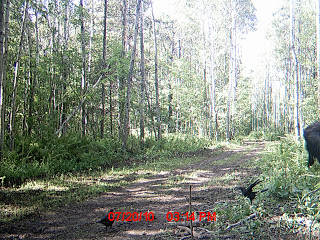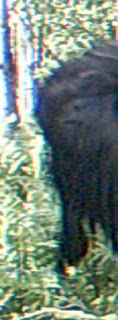What it It? – Appearances can be Deceiving
Recently, a witness named Carl (last name withheld) came forth to share a photograph of what he thinks might be a bigfoot. The picture was obtained using a game camera which was deployed in the general vicinity of the Kettle River in Minnesota. This area is largely farmland surrounded by thickly wooded swamps. The farmlands not only produce food themselves, but attract a wide variety of herbivores on which large predators can feed. The surrounding swamps are nearly impenetrable, and even if you did get in them, you’d be eaten alive by mosquitoes and other bitey things. The area in question has produced a number of bigfoot encounters for a long time, and is excellent sasquatch habitat.
The picture, seen below, shows a black figure on the right hand side of the frame that seemingly has an ape-like face. The witness pointed out the two eyes, nose, and mouth, as well as what appears to be hair cascading downwards from the hair. It was assumed that the figure was leaning into the frame of the photograph, possibly to get a better view of the camera.

After obtaining permission from Carl to study his photograph and share it on my website, he emailed me the picture, as well as several others that were taken with the same camera shortly before and after the picture in question. The first of these photos was taken a couple hours before the last three, which were apparently taken in sequence as this camera was set to take three pictures each time it was triggered. The others are not included in this blog because of the time elapsed between the shots..


Clearly, this was not a typical amorphous blobsquatch photograph showing a bigfoot (or something vaguely bigfoot-shaped) standing in the woods, so I looked at the picture with an eye to see what other kind of animal it could show. After determining witness credibility, the first lines of questioning should be directed towards exploring the possibility of a misidentification when dealing with photos.
I needed to explore some other explanation besides the bigfoot hypothesis. I first thought it might be the rear end of a moose or other large ungulate, but I soon abandoned this line of thought. I then considered the other animals visible in the photograph: crows. I had to wonder if crows would be that comfortable in such close proximity to a sasquatch. It seemed unlikely.
What I believe this photograph shows is a crow in flight, facing to the right, and partially out of frame. Feathers can be clearly seen under its outstretched right wing. The color of the figure exactly matches the colors of the other crows in the photos. I believe I see the tail feathers of the flying crow extending downwards towards the ground, behind the wings, right where I would expect them to be. I might even speculate from the position of the wings, tail feathers, and head that the crow might have been flying slightly backwards or directly vertically, as if in reaction to something out of frame, perhaps another crow competing for a food item left as bait for the game camera. The reason the crow seems so much larger than the others is that it is closer to the camera.

As ridiculous as it might sound, this isn’t the first time a crow has been misidentified as a bigfoot. There was a widely circulated game camera photograph of a crow near a game feeder from Kentucky that made the rounds in the bigfoot community a few years back. That photograph, like this one, had a crow in the foreground that appeared to be a larger dark figure in the background. The crow had its wings outstretched in flight and gave the appearance of a large, dark, shouldered bigfoot in the background largely obscured by the tall grass in which it appeared to be sitting. Indeed, appearances can be deceiving.
Carl still isn’t sure what the picture shows. It should be noted that no matter what the picture depicts, Carl did the right thing by sharing his photograph with others. This type of peer review is absolutely necessary to find the truth behind any kind of evidence that comes in. Over the years, I have heard of countless supposedly great photographs of sasquatches that the owners have never thought to share with the public for a wide variety of reasons. However, having a photograph and not sharing it is functionally identical to not having that photograph at all (which might be just fine, depending on your goals). I want to thank and congratulate Carl for sharing his picture with the rest of us.
If you have a photograph of what you think might be a bigfoot, please share it with me. I realize that many people do not want their name associated with bigfoots in any way, and I also realize that there are people out there who do not want their local bigfoots bothered by researchers. I will always respect your anonymity, and will never publish your photograph without your permission.